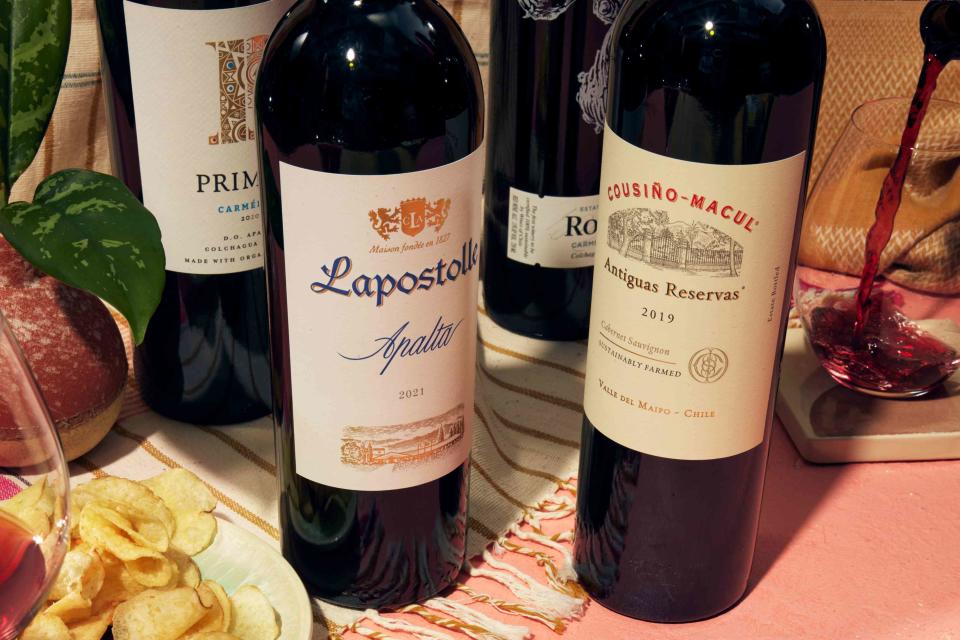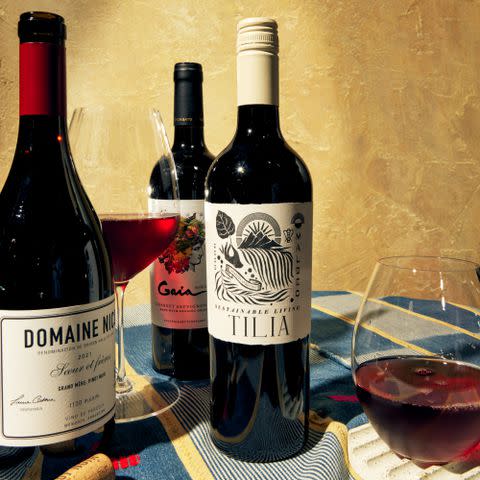16 World-Class Red Wines From Argentina and Chile
Argentine and Chilean reds are perfect for winter fare.

Grant Cornett / Food Styling by Emily Nabors Hall / Prop Styling by Claire Spollen
For me, winter means two things. First, it’s the season for cooking recipes that warm you up from the inside with a warmth that lasts: rich stews and daubes, hearty soups, and old-school classics like shepherd’s pie. Second, it calls for the wines that go with them: intense, full-bodied reds, with plenty of robust flavor and a good brawny measure of tannins as well, all the better to balance out the lusciousness of something like, oh, cassoulet. (Did I forget cassoulet in my list of warming winter dishes? Terrible oversight.)
There are lots of sources for these kinds of wines, but lately I’ve been looking to Chile and Argentina. Recent vintages have been extremely good: 2019 was stellar, 2020 impressive even during a pandemic, 2021 cooler but balanced and fresh (trickier in Chile than Argentina), 2022 again stellar. (2023 was marred by disastrous forest fires in southern Chile, sadly.) And while both countries still produce some of the world’s great values — particularly Malbec in Argentina and Cabernet Sauvignon and Carmenère in Chile — the old assumption that that’s all they can make has thankfully been abandoned. Top reds from both countries are world-class, able to compete with the best of the United States and Europe. It’s an excellent time to explore — and an excellent month for it, for that matter. After all, if you pick up a glass of South American red wine right now, you can transport yourself a few thousand miles south, where, yes, it is currently the height of summer.
Chilean red wine
2021 In Situ Reserva Carmenère ($13)
Sustainably farmed grapes from Chile’s Aconcagua Valley go into this refreshing red; it avoids Carmenère’s more herbal side, leaning instead toward dark tobacco and mulberry notes.
2022 Root:1 Carmenère ($13)
Unapologetically Carmenère, this intense red abounds with green tobacco and green peppercorn notes; they play off the wine’s basic red cherry flavor but never overwhelm it.
2021 Lapostolle Apalta ($20)
Lapostolle garnered tremendous acclaim for Clos Apalta, one of the first superstar Chilean reds. This more affordable, black cherry–ripe blend, with its soft, velvety tannins, is a nod to that wine. It’s made from 54% Cabernet Sauvignon along with small amounts of Syrah, Carmenère, Merlot, and Cabernet Franc.
2020 Primus Carmenère ($21)
Only organically farmed grapes from Chile’s Colchagua Valley are used for this savory red. The dark cherry flavors are accented by tea leaf and tobacco notes and a hint of vanilla from 18% of the wine having been aged in new oak barrels.
2019 Cousiño-Macul Antiguas Reservas Cabernet Sauvignon ($22)
Antiguas Reservas is a Chilean stalwart — the first vintage was 1927, amazingly enough — and the 2019 continues the tradition. Think red currant and raspberry flavors and a faint touch of eucalyptus.
2020 Emiliana Coyam ($36)
Emiliana is the largest biodynamic grower in Chile, and, in fact, the world. Equally impressive is this Syrah blend with its juicy, palate-whetting acidity and vivid black and red fruit notes.
2021 Concha y Toro Marques de Casa Concha Heritage ($50)
If a substantial roast is in your future, this full-bodied, powerful blend of mostly Cabernet Sauvignon (with some Cabernet Franc) is just the ticket. Its cassis and black plum flavors wrap up with firm but velvety tannins.

Grant Cornett / Food Styling by Emily Nabors Hall / Prop Styling by Claire Spollen
Argentina's red wine
2022 Tilia Malbec ($14)
This easy-going, medium-bodied Malbec from Tilia Wines in Mendoza — the winery that was the first to qualify for the Bodegas de Argentina Certified Sustainable seal — is a remarkable bargain, abounding with peppery cherry fruit.
2019 Domaine Bousquet Gaia Cabernet Sauvignon ($20)
It’s rare to find an inexpensive Cabernet that doesn’t whop you over the head with oomphy fruit, and this one fits the bill: It’s balanced and lively and, what’s more, comes from 100% organic grapes.
2021 Ver Sacrum Garnacha ($21)
This fragrant Grenache (Garnacha in Argentina) comes from multitalented winemaker Eduardo Soler — he’s also an acclaimed mountaineer and runs a ski resort near Mendoza. It’s a perfect red to serve lightly chilled, no matter the season.
2021 Clos de los Siete ($22)
France’s Michel Rolland is one of the most famous wine consultants in the world, yet his personal project in Argentina remains an absurd value. It’s elegant, with black currant and pencil lead notes: Argentina seen through a Bordeaux lens, perhaps.
2020 Viña Cobos Cocodrilo Corte ($30)
Star California winemaker Paul Hobbs has long made wine in Argentina, and his deep familiarity with the Uco Valley and Luján de Cuyo regions shows in the complexity and depth of this powerful Cabernet Sauvignon blend.
2021 Domaine Nico Grand Mère Pinot Noir ($35)
Argentina’s Mendoza region isn’t often associated with Pinot Noir, but this spicy, floral wine from Laura Catena (of the renowned Catena wine family) offers a different story. It’s impressively aromatic and silky and a true pleasure to drink.
2021 Zuccardi Q Malbec ($22)
Zuccardi’s high-end wines are some of the best in Argentina, but even their more affordable Q line offers impressive depth. This vintage of the Q Malbec is a case in point with its ripe, black-plum character lifted by a subtle herbal note.
2019 El Enemigo Cabernet Franc ($30)
This vivid red, with its blueberry-blackberry flavors and herbal edge, is just a total pleasure to drink. And if you can’t find it, El Enemigo’s Malbec is just as good, with a somewhat darker fruit character and a touch of sweet oak.
2019 Bodegas Bianchi Enzo Bianchi Gran Corte Mendoza ($60)
Grapes for this luscious Bordeaux-style blend come from 30-year-old vines high up in Mendoza. The slightly cooler temperatures there give the wine’s layers of rich blue and red fruit an impressive focus and length.
For more Food & Wine news, make sure to sign up for our newsletter!
Read the original article on Food & Wine.

